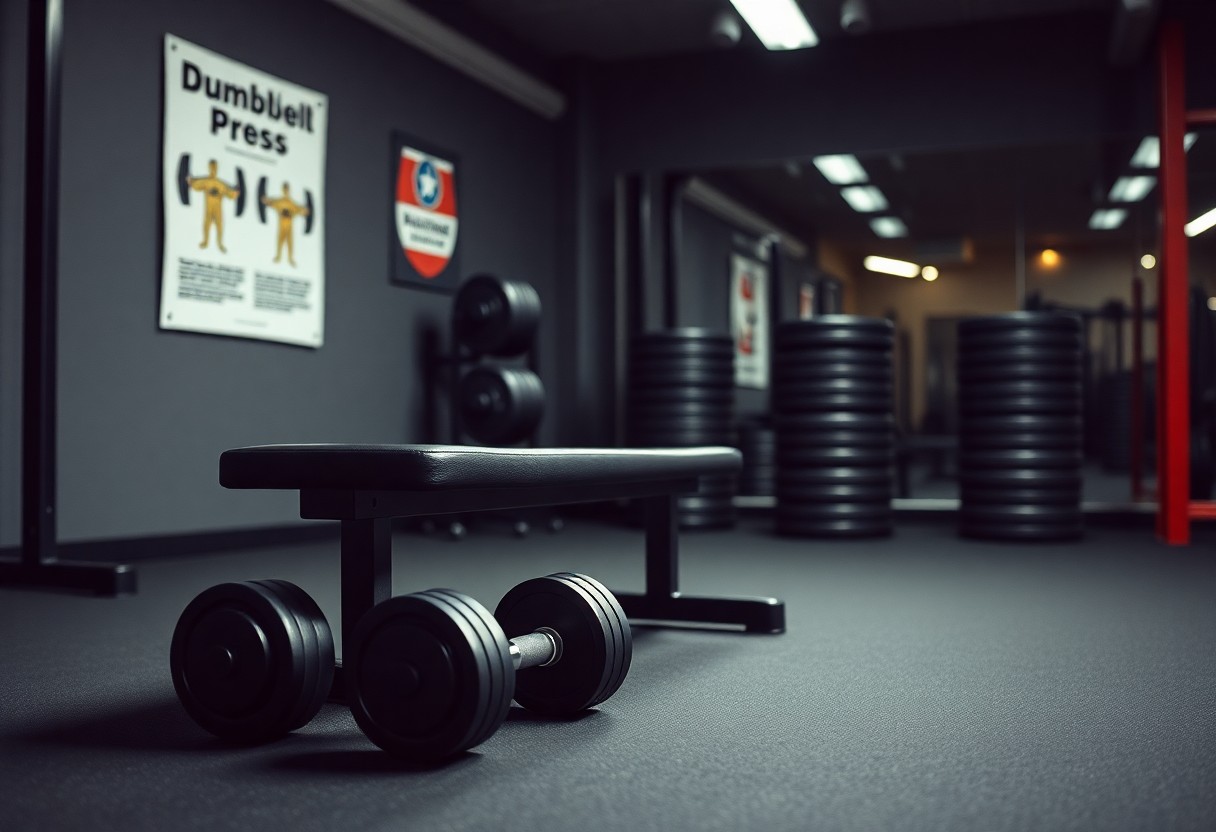There's no better way to build upper body strength than incorporating the dumbbell chest press into your workout routine. This guide will explore the numerous benefits of the exercise, ensuring you understand how to perform it with proper form. By mastering this fundamental movement, you'll unlock a variety of variations that can enhance your training regimen and effectively target your chest, shoulders, and triceps. Equip yourself with the right techniques and knowledge to maximize your results and achieve your fitness goals.

Key Takeaways:
- The dumbbell chest press effectively targets the pectoral muscles, contributing to enhanced upper body strength.
- Proper form includes keeping the elbows at a 45-degree angle to the body and ensuring the wrists remain straight.
- Variations such as incline and decline dumbbell presses can be incorporated to engage different muscle fibers and prevent adaptation.
Benefits of Dumbbell Chest Press
The dumbbell chest press offers numerous benefits that enhance upper body strength and performance. It allows for a greater range of motion compared to barbell presses and engages stabilizing muscles effectively. You can explore more on these advantages in this detailed article on Chest Press: How to, Benefits, Variations, and More.
Muscle Development
Your muscle development significantly improves with the dumbbell chest press as it targets the pectorals, deltoids, and triceps. Engaging these muscle groups through various angles helps promote balanced growth and strength, making your upper body more defined and powerful.
Improved Stability and Balance
Dumbbell chest presses require greater stability and balance than barbell variations. The independent movement of each arm activates core muscles, enhancing overall stability and reducing the risk of injury during other exercises.
By demanding more stabilization, you effectively engage muscles that might not be activated during standard exercises. This engagement leads to improved coordination and balance, translating to better performance in daily activities and sports. Furthermore, the increased proprioception helps to refine your movement patterns over time.
Enhanced Range of Motion
The dumbbell chest press promotes an enhanced range of motion, allowing you to lower the weights further than a fixed barbell. This additional stretch on the pectoral muscles leads to better muscle activation, resulting in increased strength and hypertrophy.
With a greater range of motion, you can effectively target different areas of the chest, contributing to more comprehensive muscle development. The ability to adjust your arm positions during each rep also allows you to find the most comfortable and effective angle, maximizing your workout potential.
Proper Form and Technique
Maintaining proper form during the dumbbell chest press is vital for maximizing effectiveness and minimizing injury risk. Focus on your body alignment, control, and breathing throughout the movement. As you execute the press, ensure that your grip, positioning, and movement mechanics are correct to target the intended muscle groups effectively.
Starting Position
Begin by lying flat on a bench with a dumbbell in each hand, positioned at shoulder level. Your feet should be firmly planted on the ground, ensuring stability. Keep your elbows bent to about 90 degrees and palms facing forward. Engage your core to support your back, creating a solid foundation for the movement.
Execution of Movement
Press the dumbbells upward, extending your arms until they are almost straight without locking your elbows. As you do this, exhale and engage your chest muscles. Slowly lower the weights back to the starting position while inhaling, maintaining control throughout the movement.
During the execution phase, focus on a smooth, controlled movement rather than lifting with excessive force. This approach not only enhances strength gains but also reduces the risk of injury. Adjust the weight as necessary to facilitate proper form, allowing your muscles to engage fully without compromising technique. Aim for a slow tempo—typically 2 seconds up and 3 seconds down—to maximize muscle tension.
Common Mistakes to Avoid
Avoid flaring your elbows wide, which can place undue stress on your shoulders. Also, steering clear of arching your back helps maintain stability and prevents injury. Ensure your feet remain flat on the floor; lifting them can compromise your balance during the lift.
Frequent errors include using excessively heavy weights that lead to poor form or bouncing the dumbbells off your chest. Both practices diminish the exercise's effectiveness. Additionally, don’t rush through reps; maintaining control improves muscle engagement and provides better overall results. Regularly assessing and focusing on these common mistakes will help you achieve optimal strength development in your chest workouts.
Variations of Dumbbell Chest Press
Exploring variations of the dumbbell chest press allows you to target different angles and muscle fibers within your chest. Each variation provides unique benefits, enhancing overall upper body strength. To learn more about proper techniques and additional variations, check out Dumbbell Bench Press: How-to, Tips, Variations & More.
Incline Dumbbell Chest Press
The incline dumbbell chest press emphasizes the upper portion of your pectoral muscles, promoting balanced development. Setting the bench at a 30 to 45-degree angle targets your shoulders and upper chest effectively, making it ideal for building mass and strength in these areas.
Decline Dumbbell Chest Press
Positioning the bench in a decline shifts focus to the lower chest, allowing you to develop the entire pectoral region. This variation not only enhances the definition of your chest but also assists in increasing overall pressing strength.
The decline dumbbell chest press is executed with your head lower than feet, challenging your stability and engaging your core. This angle not only allows for greater range of motion but also reduces shoulder stress compared to traditional flat presses. Incorporate this variation into your routine for a comprehensive approach to chest training, ensuring well-rounded growth and strength development.
Integrating Dumbbell Chest Press into Your Routine
Incorporating the dumbbell chest press into your workout regimen can enhance upper body strength and complement other training goals. Aim for consistent practice, adjusting volume and intensity to match your fitness level and progression. Integrate this exercise into your routine by allowing adequate recovery while maintaining regular engagement to maintain muscle improvement.
Frequency and Sets
To see optimal results, include the dumbbell chest press in your routine 1 to 3 times per week, depending on your overall training schedule. Start with 3 to 4 sets of 8 to 12 repetitions, adjusting as you build strength. Ensuring sufficient rest between sessions allows your muscles to recover and grow effectively.
Pairing with Other Exercises
Combining the dumbbell chest press with complementary exercises enhances overall upper body strength. Pair it with movements like rows, shoulder presses, and tricep extensions for a balanced workout targeting all major muscle groups. This synergy helps to improve muscle coordination and development.
For a well-rounded upper body routine, combine the dumbbell chest press with pulling movements such as bent-over rows or pull-ups to engage opposing muscle groups. This approach not only balances the workout but also promotes muscle symmetry. Adding tricep extensions or lateral raises directly after the chest press can create a dynamic superset, amplifying the intensity and efficacy of your training session. Consider incorporating these pairs to challenge your muscles and enhance overall performance.

Safety Considerations
Prioritizing safety during your workout minimizes the risk of injury and ensures effective training for your upper body. Always use a spotter when lifting heavier weights and remain aware of your surroundings to avoid accidents. Engaging in proper breathing techniques and controlling the weights throughout the movement also enhances safety. If you feel any unusual pain or discomfort, it’s wise to stop your workout immediately.
Warm-up and Stretching
Engaging in a thorough warm-up routine and stretching before your workout prepares your muscles and joints for activity. Five to ten minutes of cardio, such as jogging in place or jumping jacks, increases blood flow, followed by dynamic stretches targeting the chest, shoulders, and arms. This not only enhances performance but also reduces the risk of injury during the dumbbell chest press.
Using Proper Weight
Selecting an appropriate weight is crucial for maximizing the effectiveness of your dumbbell chest press while minimizing injury risk. Start with a weight that allows you to complete 8-12 repetitions with proper form. If you can easily exceed this range, it's time to increase the weight. Conversely, if you struggle to maintain form during the last few reps, consider reducing the weight to ensure effective training without sacrificing safety.
Using proper weight requires ongoing assessment of your strength and endurance levels. During each session, evaluate how comfortable you feel while performing the exercise. If you find yourself consistently hitting the maximum rep range, gradually increase the weight by 5 to 10 percent. Additionally, pay attention to your body's feedback; it's vital to maintain form and control rather than simply lifting heavier weights. If fatigue sets in or form breaks down, drop the weight until you build the necessary strength to progress safely.Conclusion
With this in mind, incorporating the dumbbell chest press into your workout routine can significantly enhance your upper body strength and promote muscle growth. Focusing on proper form ensures you maximize benefits while minimizing the risk of injury. Variations allow you to target different muscle groups for a well-rounded training approach. To further refine your technique, check out this guide on How to Dumbbell Bench Press: Form, Benefits, and .... Embrace these principles for optimal results.
FAQ
Q: What are the main benefits of the dumbbell chest press?
A: The dumbbell chest press enhances upper body strength, targets the pectoral muscles, improves shoulder stability, engages supporting muscles like the triceps and deltoids, and allows for a greater range of motion compared to barbell presses.
Q: How do I perform the dumbbell chest press with proper form?
A: Start by lying on a flat bench with a dumbbell in each hand, arms extended above your chest, palms facing forward. Lower the dumbbells until your elbows are at about a 90-degree angle while keeping your feet flat on the ground. Push the dumbbells back up to the starting position while maintaining control throughout the movement.
Q: What variations of the dumbbell chest press can I try?
A: Variations include the incline dumbbell chest press, which targets the upper pectorals; the decline dumbbell chest press, focusing on the lower chest; and the single-arm dumbbell chest press for unilateral strength development and stability improvement.
Q: How often should I include the dumbbell chest press in my workout routine?
A: Incorporate the dumbbell chest press 2-3 times per week, allowing at least 48 hours of rest between sessions to promote recovery and muscle growth.
Q: Can beginners safely perform the dumbbell chest press?
A: Yes, beginners can perform the dumbbell chest press by starting with lighter weights to master the form. Gradually increase the weight as strength improves while focusing on controlled movements and proper technique.







0 Comments